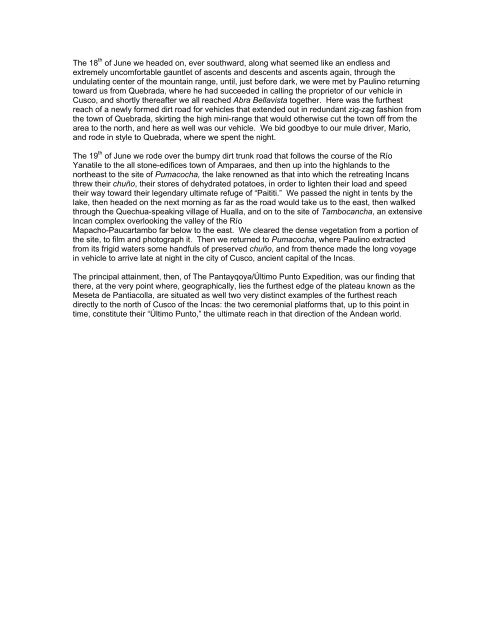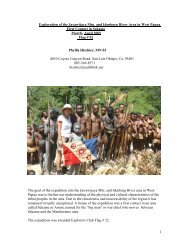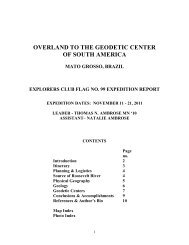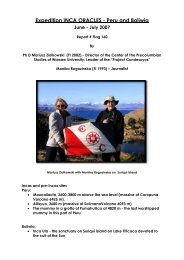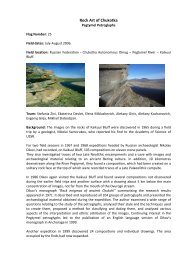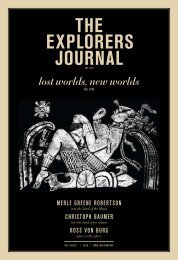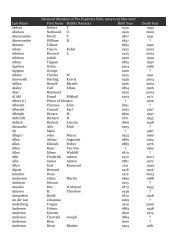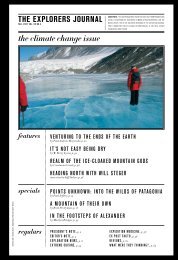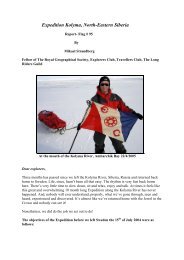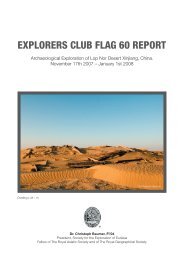Download Report Here - The Explorers Club
Download Report Here - The Explorers Club
Download Report Here - The Explorers Club
Create successful ePaper yourself
Turn your PDF publications into a flip-book with our unique Google optimized e-Paper software.
<strong>The</strong> 18 th of June we headed on, ever southward, along what seemed like an endless and<br />
extremely uncomfortable gauntlet of ascents and descents and ascents again, through the<br />
undulating center of the mountain range, until, just before dark, we were met by Paulino returning<br />
toward us from Quebrada, where he had succeeded in calling the proprietor of our vehicle in<br />
Cusco, and shortly thereafter we all reached Abra Bellavista together. <strong>Here</strong> was the furthest<br />
reach of a newly formed dirt road for vehicles that extended out in redundant zig-zag fashion from<br />
the town of Quebrada, skirting the high mini-range that would otherwise cut the town off from the<br />
area to the north, and here as well was our vehicle. We bid goodbye to our mule driver, Mario,<br />
and rode in style to Quebrada, where we spent the night.<br />
<strong>The</strong> 19 th of June we rode over the bumpy dirt trunk road that follows the course of the Río<br />
Yanatile to the all stone-edifices town of Amparaes, and then up into the highlands to the<br />
northeast to the site of Pumacocha, the lake renowned as that into which the retreating Incans<br />
threw their chuño, their stores of dehydrated potatoes, in order to lighten their load and speed<br />
their way toward their legendary ultimate refuge of “Paititi.” We passed the night in tents by the<br />
lake, then headed on the next morning as far as the road would take us to the east, then walked<br />
through the Quechua-speaking village of Hualla, and on to the site of Tambocancha, an extensive<br />
Incan complex overlooking the valley of the Río<br />
Mapacho-Paucartambo far below to the east. We cleared the dense vegetation from a portion of<br />
the site, to film and photograph it. <strong>The</strong>n we returned to Pumacocha, where Paulino extracted<br />
from its frigid waters some handfuls of preserved chuño, and from thence made the long voyage<br />
in vehicle to arrive late at night in the city of Cusco, ancient capital of the Incas.<br />
<strong>The</strong> principal attainment, then, of <strong>The</strong> Pantayqoya/Último Punto Expedition, was our finding that<br />
there, at the very point where, geographically, lies the furthest edge of the plateau known as the<br />
Meseta de Pantiacolla, are situated as well two very distinct examples of the furthest reach<br />
directly to the north of Cusco of the Incas: the two ceremonial platforms that, up to this point in<br />
time, constitute their “Último Punto,” the ultimate reach in that direction of the Andean world.


